Many years ago, I was criticized for serving spaghetti un-assembled. “Uncooked”
was the word used – because I brought my spaghetti to the table with the
noodles not mixed with the sauce. I had always served it this way but since
that comment, I conformed by mixing everything in the pot, at the stove.
Today, I decided to go back to my old way of serving spaghetti: the
noodles are in a bowl separate from the meat sauce, with cheeses and peppers at
the ready.
As I enjoyed my freshly-assembled personal portion of spaghetti, I was taken back to why I
had always done it this way before. Here are my reasons for going back to assembling spaghetti at the table (after years of doing it the other way):
- The noodles don’t suck up the sauce. When you mix the sauce and the noodles in the pot, the noodles absorb the sauce, so that by the time the dish reaches the table, the pasta is past the al dente stage.
- You determine the sauciness of your spaghetti portion. Do you want it dry-ish? Or soupy? Maybe you want more sauce than meat? More meat than sauce? You’re in control here.
- Your spaghetti meal can be your own creation. More cheese? Some hot pepper flakes? Sweet like the Pinoy spaghetti? Garlicky? With anchovies? You can whip up your own tasty concoction – you don’t have to be content with what the cook considers his masterpiece.
- Leftover already-mixed spaghetti is not very appetizing. After refrigeration, the sauce is dry and the noodles are too soft and fat. If the refrigerated sauce is separate from the noodles, you can reheat it to its original state. You can reheat the noodles with a little hot water, on the stove or in the microwave. Assemble at the table and you’ll forget that they’re leftovers.









































.jpg)










